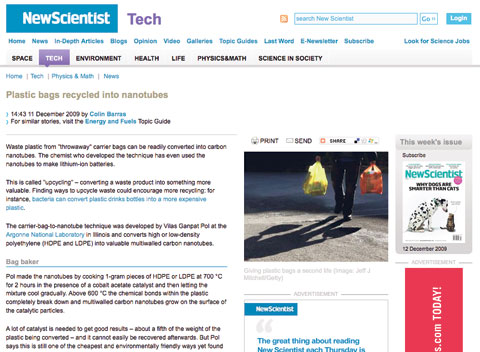Waste plastic from ‘throwaway’ carrier bags can be readily converted into carbon nanotubes, the New Scientist reports in last week’s issue.
Waar kom je vandaan?
“Ik volg het college flight dynamics, maar heb vandaag de helft geskipt omdat het te droog was. De professor liet voor het eerst een promovendus het college geven, maar deze sprak zo saai dat ik me bedacht dat ik meer lol zou beleven als ik thuis het boek ging lezen.”
Wat ga je zo doen?
“Mijn mail lezen. Mijn laptop is kapot en morgen komt de nieuwe pas. Daarna ga ik studeren en naar huis. Niet echt spannend, nee. Maar vorige week was Kriminele, dus deze week moet ik hard studeren.”
Gaat het goed met de studie?
“Ja. Ik studeer ook nog Chinees in Leiden en heb nu van beide bijna mijn bachelor, dus dat gaat wel lekker. Straks ga ik hier aan mijn master beginnen, dan houd ik op met studeren in Leiden.”
Doe je nog iets naast je studie?
“Op dit moment ben ik bezig met de studentenstichting Sife. Dat is een landelijke stichting. Eind december hebben we een Delftse afdeling opgericht, die explosief groeit. We begonnen met z’n vieren en hebben inmiddels veertien man.”
Wat doet Sife?
“We nemen deel aan wereldwijde projecten op het gebied van maatschappelijk ondernemen. In Sierra Leone bijvoorbeeld is een waterkrachtcentrale kapot gegaan. Wij stellen nu samen met de bevolking een plan op voor de distributie van elektriciteit. Bovendien leren we de mensen in het dorpje hoe zij zulke problemen zelf kunnen oplossen.”
Ga je daar zelf ook heen?“Nee, ik heb het straks veel te druk met mijn master.”
The chemist who developed the technique, Vilas Ganpat Pol, of the Argonne National Laboratory in Illinois, has even used the nanotubes as anode material to make lithium-ion batteries. “And it worked fantastically”, he says in New Scientist. Usually graphite or carbon black is used for this purpose. A scientific article about this ‘upcycling’ – converting a waste material into something more valuable – appeared last month in the Journal of Environmental Monitoring.
Polyethylene-based used plastics – best known as plastic bags from the supermarket -need hundreds of years to degrade in atmospheric conditions. These bags can have a severe negative impact and are being produced in escalating quantities; therefore, according to the chemists from Illinois, in addition to conventional recycling facilities, innovative solutions are required. The chemists cooked small pieces of the plastic at 700°C until all chemical bonds broke down. Mixed with cobalt acetate, which serves as a catalyst, the lose carbon atoms then grew into multi-walled carbon nanotubes with cobalt inside.
Promising technique? “Well, I’m not too sure about that,” says Professor Stephen Picken, polymer expert at TU Delft’s faculty of Applied Sciences. According to Picken, there are much more effective ways to recycle plastic. “In Europe we recycle 40 percent of that waste, a part of which we melt and reuse as plastic,” says Picken. Plastic is also shredded and used as a filling material and compressed into objects, like park benches and poles. About 20 percent disappears in the ground. The rest is burned, which is not waste either, because this creates precious energy.
But the waste stream is probably worse in many other countries. “Maybe less plastic is recycled in the United States,” says Picken. “I don’t know how it is over there, but still I find it strange that the researchers emphasize the fact that they could solve the waste problem. There is way too much plastic waste compared to the amount of anode material that batteries require.
“Perhaps it is possible to produce high quality carbon nanotubes from plastic. This is certainly a research field on which we have to keep an eye. But I must say that I’m not very impressed by the quality of the nanotubes that these researchers created so far. From the pictures I’ve seen in their publication, they don’t seem very long and straight. I think that if they want to demonstrate the potential of creating useful nanotubes for batteries from plastic, they should start by using pure polyethylene. I think their approach is quite stupid.”
Pickens’ colleague, Professor Andreas Schmidt-Ott, wonders why this research was published in the Journal of Environmental Monitoring and not in a magazine specialized in nanotechnology.
“Maybe the reason is that these kinds of magazines didn’t think the technique is interesting enough,” he says. “The problem with his technique is that it is not a continuous reaction; it’s a batch process. You can only make relatively small amounts at a time. So I don’t see how this can solve the waste problem, even if in the future there is more demand for carbon nanotubes for batteries.”
Do you have a question or comment about this article?
tomas.vandijk@tudelft.nl


Comments are closed.